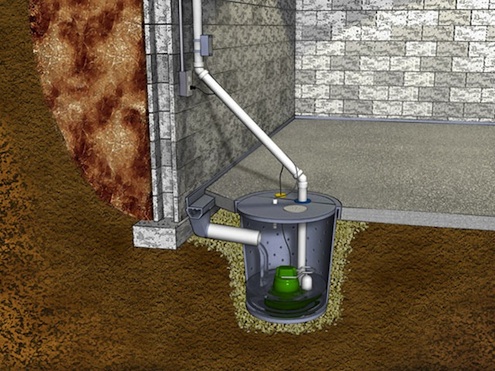What is a Sump Pump?
Hidden in the deepest part of your basement or cellar, a sump pump generally goes without notice, however one day it could be the most important device in your home…

Sump Pump Illustration
Photo: Umbrella Plumbing
In general terms, your sump pump eliminates ground water from below your home. Without it, water arising from the ground, or leaking in from a heavy downpour can flood your basement, your crawlspace and even your whole home.
Sump Pumps are normally set into a pit that’s been set into your basement floor or crawlspace. The floor is set so that it is a little downhill so that any liquid will stream towards the pit. The sump pump ejects this water out of the house.
The pump is at the bottom of the sump hole and has a switch that is activated instantly by the raising water level. When you have water in your basement, because of the slant towards it, the water encounters the pit and the pump is activated and pumps the water out of the pit through a discharge pipe to the exterior.
Do I Really Need a Sump Pump?
If you are asking “So, what is a sump pump?” then I’m guessing you’re lucky enough that you probably do not require one. But for the less-fortunate owners of wet or damp basements, then yes, you will need one. There are many different kinds of Simp Pump readily available, so below I’ll cover off the main types
Pedestal Pumps
A pedestal pump is one of the most typical types of sump pump. This kind of pump has a motor installed on to a small pedestal. The whole system typically stands about 30 inches tall. A tube or a pipeline extends down from the motor to the bottom of the pit. When the pump is triggered by the increasing water level, the water is sucked up through the hose pipe and ejected through another pipeline.
Submersible Pumps
Another type of sump pump is a submersible pump. These are typically much smaller and are approx about 12 inches high and are normally set into the bottom of the sump pit. Some submersible sump pumps have a float on a rod just like the pedestal pump, however with these paricular types of sump pump, the rod is much smaller, sized at about 4 inches (100mm) long. The electrical switch itself is framed in a plastic bubble and as the water level in the sump increases, the bubble rises. When it floats high enough to reach a practically vertical position above the pump, the switch is triggered and the pump kicks on.
Ejector Pumps
Some of us will need to have the ability to eject some small items of debris along with the water and this is when an ejector pump will do. Perhaps like many of us, you have a crawlspace that is not concrete – perhaps it’s gravel of some sort…In this scenario an ejector pump that can also remove loose items of debris within the water is going to be the best option for you. Being a little more expensive, ejector pumps are normally built of “pig” or cast iron and have a 2-inch ejector port instead of the smaller, standard 1 1/4- inch port that you discover on the majority of the other kinds of sump pumps. This broader pipe width/diameter and also having a different design of pump mechanism permits these pumps to process small pieces of gravel and debris without mechanism being damaged.
More Reading About Sump Pumps:
This article really only touches on Sump Pumps, so if you want to find out more and read some reviews regarding Sump Pumps click the link below: